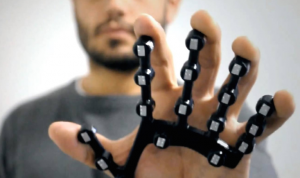
dbGlove is a sensory device designed to help the deaf-blind communicate. Image Source
The dbGlove is set to be released in early 2016. This technology is designed to help the deaf-blind more easily communicate by taking advantage of their iPhone. dbGlove makes use of the Malossi alphabet, a communication method involving the use of a person’s hand as a typewriter. (see infographic below)

Description of The Malossi Alphabet. Image Source
The dbGlove consist of a sensory pad that sits in a users left hand. The user acts as their own typist and inputs the letters that are then transmitted to their iPhone via Bluetooth. Once there, that message can be displayed to a non-user, transmitted to speech, or sent to someone. Responses are then received as vibrations representing the touch cues the communication partner would exercise.
This development is particularly interesting to me because I had a similar project in high school. Obviously it is not as high-tech as the dbGlove, but we had very similar goals. The Speakey Speakey is designed to take input from an American Sign Language (ASL) user and display the letters on an LCD screen.
The goal was to facilitate communication between ASL users & non-users. The Speakey Speakey takes advantage of the Makey Makey (developed at MIT!) that allows anything that is conductive to be used as a key on a keyboard. The glove takes in these manual inputs, submits it to the Arduino, and displays it on the screen once the user taps the return “key” on the glove.
Deeper research & further development on the Speakey Speakey could’ve led to a similar impact as the dbGlove. So close, yet so far.
